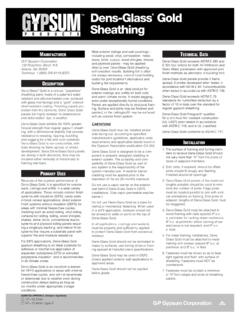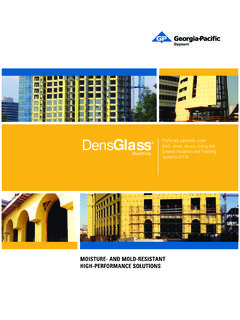Transcription of EXTERIOR INSULATION AND FINISH SYSTEMS - Drying …
1 EXTERIOR INSULATION AND FINISH SYSTEMS (AND OTHER PROBLEMS WITH BUILDING ENVELOPES)ByN. Hall, , P .E., system OR EIF system ?EIFS stands for " EXTERIOR INSULATION and FINISH system ." Some folks contend that thecorrect pronunciation is "Efs" and not "E-fus." These people are specs writers. Chase them offyour job sites. Other folks argue that the term "EIFS system " is redundant and the correct termis "EIF system ." They also say "OSB" instead of "OSB board." These people are value engi-neers. Shoot ORIGIN OF EIFSIt was first developed in Europe after World War II as a means for the rapid reconstruction ofwar-torn towns and cities.
2 The energy crisis necessitated the development of retrofit wall sys-tems that added a layer of INSULATION to the outside of existing walls. European constructiontypically consisted of a masonry wall clad with cement stucco. Materials such as cork, rockwool and fiberglass were unsuitable for use either as EXTERIOR cladding or with stucco FINISH . Bythe 1960s, expanded polystyrene became available. Despite their otherwise compatibility, thecoefficient of expansion and contraction for polystyrene is about six times that of cement stuc-co. As a result, synthetic stucco utilizing polymer chemistry replaced traditional hard stucco asthe FINISH coat in prototypical EIFS.
3 Recently, the use of acrylics is being challenged by vinylacetate ethylenes (VAEs), a European product with unproved moisture resistance and fire re-tardancy (most EIFS SYSTEMS cannot be used in interior space because of low flame spread rat-ings).In addition to lowering energy bills, the EXTERIOR placement of INSULATION reduced thetemperature difference between habitable space and building structure. This reduced the ten-dency for building components to move, crack and offer pathways for moisture popularity of EIFS then spread across the Atlantic. The first use of EIFS in the UnitedStates was in 1969 by Dryvit system . Between 1969 and 1976, national EIFS sales remainedbelow $2 system TYPES"First generation" EIFS with which most of us are familiar is now called "barrier"EIFS because it was designed to keep water from penetrating the synthetic stucco EIFS is a non-load bearing cladding system consisting of (1) INSULATION board adheredor mechanically fastened to a substrate such as plywood or OSB board, (2) glass fiber reinforc-ing mesh, (3) base coat on the face of the INSULATION board that functions as a weather barrierand (4) a textured protective FINISH coat.
4 "Second generation" EIFS was developed in response to the high numbers of in-stances that water infiltrated behind the weather barrier of barrier are six basic types of EIFS )Class PB SYSTEMS (Polymer Based EIFS) use expanded polystyrene rigid in-sulation, a reinforcing mesh embedded into the base coat and usually a 1/8-inch thick coat-ing of synthetic stucco (or lamina), depending on the thickness of the mesh. PB Systemsare also called "original" or "soft" )Class PM SYSTEMS (Polymer Modified EIFS)use extruded polystyrene rigid insu-lation, a reinforcing mesh installed over the surface of the INSULATION board and a 1/4inch to 3/8-inch thick base coat regardless of the thickness of the mesh.
5 PM SYSTEMS were developed forimpact resistance and are also called "hard" )DEFS (Direct-applied EFS)is an EXTERIOR FINISH system (without INSULATION ) de-signed for direct installation onto substrates such as Dens-Glass Gold or Cement Board. DEFSis typically used at soffits, stairwells, balcony walls and areas subject to high impact4)OCS (One Coat Stucco)is applied like traditional stucco (with metal lath orstucco netting) but uses a polymer modified stucco mix "right out of the bag".5)Quick Ris a polyisocyanurate rigid wall INSULATION designed for use under bar-rier EIFS. Typically it is fastened over masonry block to met new energy codes and pro-vides an even substrate surface6)Drainage EIFSis a polymer based system introduced in 1996.
6 In most "drainage"EIFS SYSTEMS the INSULATION board is grooved to permit water to run down the wall to weepsinstalled at the bottom of the cladding. A drainage plane such as Tyvek or felt paper is in-stalled between the INSULATION board and PROBLEMSMost damage from water intrusion occurs at window openings, deck attachments androof lockout flashing. An on going study (albeit incomplete) by HUD found that many com-mon deficiencies are caused by poor workmanship, such as1)Thin base coat. Applications with base coats thinner than the manufacturer's re-quired thickness were )Exposed mesh. Many jobs had exposed mesh at joint edges and at that is not fully embedded is exposed to moisture and won't provide good impact )Sealant at EIFS field joints were common, typically cohesivefailure of the FINISH )Cracking in V-grooves.
7 Cracking is most common when the V-groovefalls on an INSULATION board joint )Cracking at at the corners of windows and similaropenings are caused by stresses at the reentrant (inside) )Cracking at board not associated with openings or joints occurredover the gaps between INSULATION boards and grow worse as the reinforcing mesh loses tensilestrength from exposure to moisture and BREWINGD ryvit and other large manufactures concentrated on commercial markets until the1980s. Then, large and smaller companies joined with local homebuilders associations to attackthe residential market. By 1994, 35% of new homes were being clad with EIFS.
8 In 1995 nearly50% of new homes in the Virginia Beach area had at least some EIFS on them. As the marketboomed, quality control became the first early as 1994, homeowners in Wilmington, North Carolina complained of waterintrusion, mold, wood rot and insect infestation in the EXTERIOR walls of their EIFS-clad inspectors discovered that the EIFS was installed without flashing and sealant. Watereasily flowed behind the synthetic stucco cladding. High relative humidity of the coastal arearetarded evaporation within the American Institute of Architects (AIA) Task Force conducted a survey in Wil-mington in 1995. 209 homes were inspected in 16 subdivisions, involving 19 builders, 10 ap-plicators and 12 manufactured EIFS SYSTEMS .
9 68% of the installations had improper or nocaulk joints which at the time were required by most EIFS manufacturers. 94% of the residen-tial homes inspected suffered from some degree of water intrusion. The Task Force concludedthat Wilmington homes with EIFS had "significant problems with moisture within causing accelerated rotting and decay of construction materials." The cause of theproblem in part "is the inability of EIFS SYSTEMS , as presently engineered and applied, to ade-quately dram moisture once it is within the walls of a structure."As a result of the North Carolina experience, a class action lawsuit(Ruff v Parex)wasfiled.
10 The particulars of the lawsuit are available at Reportedly Syner-gy agreed to contribute $20 million to help repair residential homes that sustained damage tohomes clad with products sold under the Synergy or ThoroWall brands. The class action suitcontinues against Dryvit, Sto, Parex, Bonsal, Continental Stucco, Thomas Waterproof Coat-ings, United States Gypsum and Shield those interested in inspecting EIFS, the website includes the EIFS Inspection Pro-tocol mandated by order of the Court. This protocol specifically applies to the Synergy classaction settlement in North Carolina, but it has become a nationwide industry standard.

